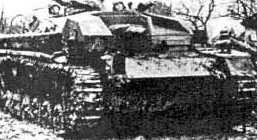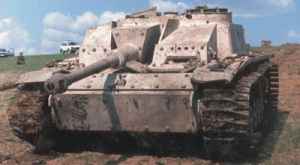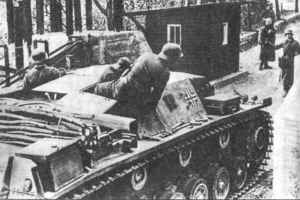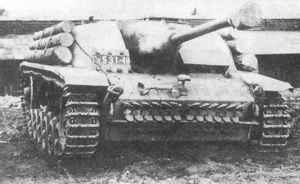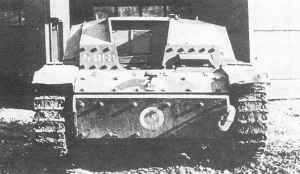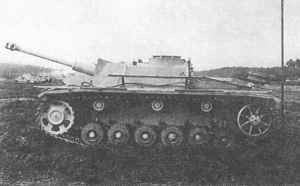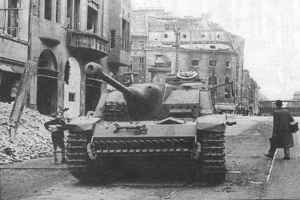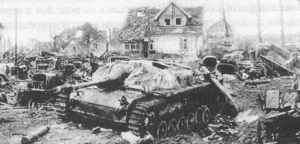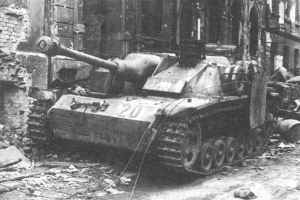Stug III was one of a series of assault guns/tank destroyers produced by the Germans during the war. Assault guns were easier, cheaper and less time consuming to produce than turreted tanks and that is why German factories built them in large numbers. Cost of single Ausf G was 82500RM making it cheaper than both PzKpfw III Ausf M at 103163RM and PzKpfw IV Ausf F2 at 115962RM. It is interesting to see that almost four Ausf Gs could be purchased for the cost of single King Tiger.
In August of 1940, Sturmartillerie units were reorganized into Abteilungen (battalions) with 18 assault guns in three batteries (with 6 assault guns each). In early 1941, the battalions were renamed - Sturmgeschuetz Abteilungen and batteries to Sturmgeschuetz Batteries. In March/April of 1941, all Sturmgeschuetz Batteries had the number of assault guns increased to seven. In 1942, with the introduction of long-barrelled Stug III (75mm L/43 and L/48), Sturmgeschuetz Abteilungen were reformed and number of assault guns was increased to 28 per battalion. Each battalion still had three batteries but number of assault guns in platoons was increased to three. In November of 1942, Sturmgeschuetz Abteilungen were reformed again and number of assault guns was increased to 31 per battalion with three additional assault guns for battery commanders. This type of organization often referred to as Sturmgeschuetz Brigade remained in use until the end of the war. In June of 1944, new organization scheme was introduced - Sturmartillerie Brigade with 45 assault guns, including 33 Stug III/IV (75mm L/48) assault guns and 12 Sturmhaubitze 42 (105mm L/28) assault howitzers. Brigade had three batteries with 2 Stug IIIs for each battery command, while each battery had two platoons of four Stug IIIs and one of four StuH 42s. This organization scheme was used alongside the Sturmgeschuetz Brigade scheme to the end of the war. In practice, these ideals were hardly ever achieved and then only highly favoured formations received the full complement.
Towards the end of the war, Stugs (40) were often issued to other units as replacement for tank destroyers and even tanks. Since 1944, Stug III (40) were also used as replacements for PzKpfw III, PzKpfw IV and even PzKpfw V Panther in Panzer Abteilungs. That practice was a mistake, but the desperate situation and the overall shortage of tanks made it a necessity. During the course of war, Stug III assault guns were issued to Sturmartillerie Batteries, Sturmgeschuetz Abteilungen, Sturmgeschuetz Brigades, Sturmartillerie Brigades, Ersatz (Reserve) Abteilungen and Funklenk (Remote Control) Companies. Stug III assault guns served on all fronts of WWII to the end of the war. Only, elite Wehrmacht (e.g. Grossdeutschland) and Waffen SS (eg. LSSAH, Das Reich, Totenkopf) divisions had Sturmgeschutzbrigaden as permanent part of their divisions.
Sturmgeschutz III was originally designed as an assault weapon, but as war progressed it became more of a defensive one. It evolved into an assault gun and tank destroyer in one. Its main role was to providing anti-tank support to the units in its area of operation.
In 1935, Colonel Erich von Manstein proposed that Sturmartillerie units were to be formed and used for direct support of infantry divisions. They were to be equipped with assault guns mounted on tracked chassis. Used to accompany the infantry into the attack, the assault gun's main aim was to knock out pill-boxes, machine gun nests, anti-tank guns and other obstacles.
On June 15 1936, the order was given to Daimler-Benz AG to develop and produce an armored infantry support vehicle mounting 75mm gun. The gun was to have a limited traverse of minimum 25 degrees in order to provide direct support up to 6 kilometres. The gun was to be mounted in a superstructure that provided full protection for the crew. The height of this vehicle was not to exceed the height of an average man. Daimler-Benz AG being already involved in the development and production of Panzerkampfwagen III tank decided to use its chassis and components for this new vehicle. The experimental "0" series of five prototypes (chassis number 60201 to 60215) was produced in 1937 by Daimler-Benz - Pz.Sfl.III (s.Pak). Prototypes were pre-production Panzerkampfwagen III Ausf B tanks mounted with mild-steel superstructures housing short-barrelled 75mm StuK (Sturmkanone) gun designed and produced by Krupp. Vehicles were extensively tested at Kummersdorf, Doberitz and other testing / training facilities e.g. Jueterbog. Prototypes remained in use as training vehicles as late as 1942.
First production vehicles based on Panzerkampfwagen III Ausf F chassis and components, entered production in 1940. The 75mm StuK 37 L/24 gun was mounted offset to the right in a sloped superstructure. Superstructure was made of armor plates and was mounted on the welded hull. Side hull escape hatches present in the original Panzerkampfwagen III Ausf F hull were removed and frontal hull armor protection was increased from 30mm to 50mm. From January to May of 1940, 30 Sturmgeschutz III Ausf A were produced by Alkett.
First 24 Stug III Ausf A assault gun out 30 produced equipped Sturmartillerie Batteries 640, 659, 660 and 665 and first saw service during the French Campaign. Each battery according to organization scheme from November of 1939 had 6 assault guns in three platoons (with 2 assault guns each). Sturmartillerie Battery 640 became organic to Infantry Regiment Grossdeutschland and was renamed to 16th Sturmartillerie. Last 6 assault guns were issued to SS Sturmartillerie battery of Leibstandarte SS Adolf Hitler division. Two more batteries were formed - 666th and 667th but didn't see combat in France.
|



